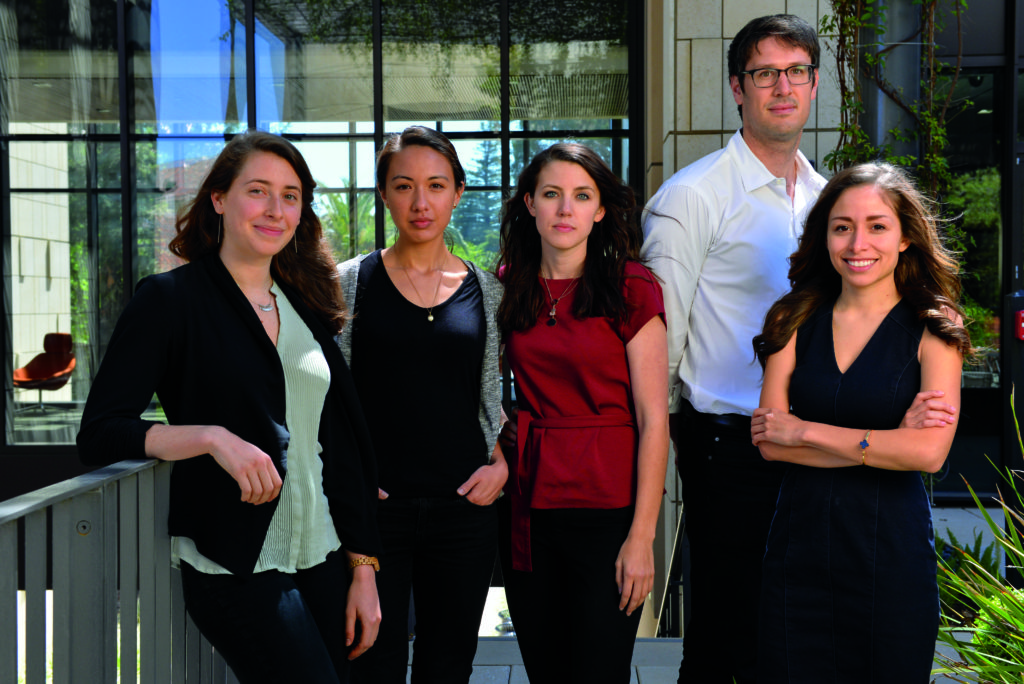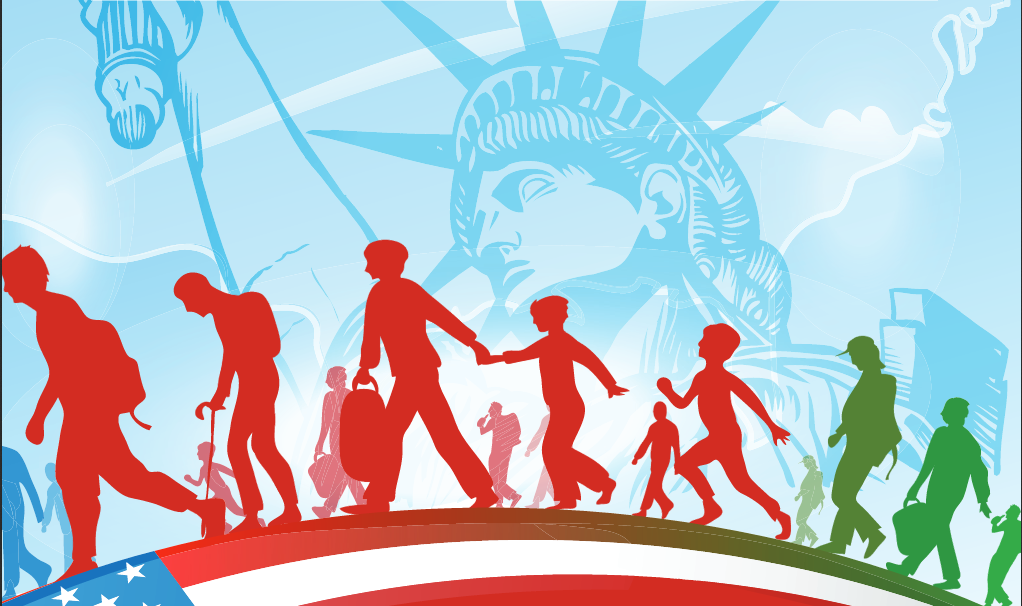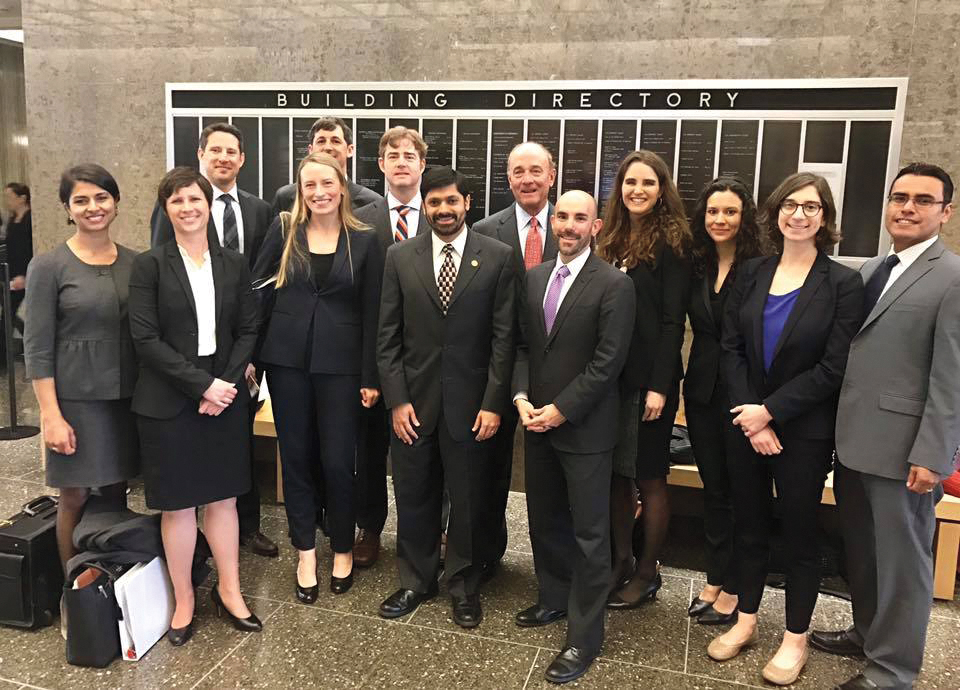Tackling Legal Challenges of Immigration
While reform of what many see as a broken immigration system has been a political football tossed from both sides of the aisle, last year’s presidential campaign put the issue front and center. Since the election of President Donald Trump, promises he made on the campaign trail have quickly turned into presidential action. And that has led many law students to take action of their own. Prompted by these policies, law students launched a new group in November, Stanford Advocates for Immigrants’ Rights (SAIR).
“After the election, a lot of us reached out to Jayashri and Lisa, who run the Immigrants’ Rights Clinic, and Jayashri brought us all together, saying that we should have a meeting and figure out what can be done,” says Haley Millner, JD ’18. “We hadn’t really united as students interested in immigrants’ rights issues before that moment.”
“The impetus behind the group was to do what we can, as law students, with faculty and other members of the Stanford community, to stand with immigrant communities and help protect their rights,” says Max Schoening, JD ’18, adding that over a hundred students from the law school and across campus have signed up with the group to help.

“President Trump’s executive orders span a broad range of activity,” says Jayashri Srikantiah, director of the Immigrants’ Rights Clinic and SAIR faculty mentor. She explains that there are three executive orders concerning immigrants. The first is the travel ban, also known as the Muslim ban; the second involves border enforcement, which covers refugees and asylum seekers and others who are trying to enter the U.S.; and the third concerns interior enforcement policies governing who’s already here and how Immigration and Customs Enforcement should treat those individuals.
“These areas—the interior enforcement, the border enforcement, and the international community and legal implications—all have their own unique legal challenges,” says Adrienne Pon, JD ’18. “Some of it is ground that has been trod upon before, certain constitutional rights that we know. But a lot of it is also testing the bounds of the law in ways that really haven’t been challenged—relying on parts of statutes that haven’t been used in the same way, relying on parts of the Constitution so that there is much debate about their interpretation.”
SAIR’s activities attempt to address many of the challenges facing immigrants in light of the administration’s initiatives.
Millner cites one of SAIR’s efforts: Teach-ins to help students better understand the law and the new policies that immigrants are facing or may face. “We felt that there was a need for understanding what immigration law is, and what problems immigrants face today,” says Millner, noting that there have been four sessions so far covering Deferred Action for Childhood Arrivals (DACA),
Immigration Law 101, how the immigrant community is affecting the U.S. economy, and immigrants’ rights during detention.
Students also established a Research Bank to provide extra research capacity to nonprofits working on immigrants’ rights issues, partnering primarily with the ACLU, the Asian Law Caucus, and Legal Aid at Work.
“In our short couple of months, more than 30 students have put together over 50 complex research memos that have been used in active litigation and various other efforts,” says Pon.
(article continues below)
Yet another key project for the group is pro bono legal work.
“We wanted, essentially, a direct service volunteer army on call so that we could respond to new policies as they were released, such as the travel ban,” says Tory Tilton, JD ’18. “So we partnered with the pre-existing immigration pro bono program at Stanford Law School. And we were able to sign up dozens of additional pro bono volunteers.”
Tilton explains that with new policy announcements coming at a fast clip, the need for volunteers to mobilize quickly is essential. “Within 48 hours of the January travel ban executive order, we were able to rally pro bono volunteers to provide one-on-one services for people in the Stanford community who were directly affected.”
For Elena Rodríguez Armenta, JD ’18, who led two of the teach-ins, one on DACA and one an introduction to immigration law, this work touches close to home.
“Immigration is the story of my family and my own personal story. My grandparents raised me in Matamoros, Tamaulipas, Mexico, until my mother and I moved to Brownsville, Texas, which is right across the border on the U.S. side between southern Texas and northern Mexico. The community I’m from is very much directly affected by anything that the current administration does,” she says. “SAIR for me was as much a reaction out of fear as it was of solidarity with my home.”
Rodríguez Armenta is fluent in Spanish so she often volunteers for one of the group’s regular pro bono activities with the nonprofit Community Legal Services in East Palo Alto.
“The saddest and most rewarding thing about immigration pro bono work is having people connect with you because you are a part of their community. It opens up a level of comfort that allows them to cry with you, for one, and express their enormous fear,” she says. “It gives me a continued sense of obligation to keep coming back to this work.”
Pro Se Guide for Asylum Seekers
As a result of the administration’s policies, the number of people in deportation hearings is increasing. Many of these individuals do not have attorneys and have to represent themselves pro se.
“President Trump’s policies target not only people who are undocumented, and that’s about 11 million including children brought here when they were young—the DREAMers—but also people who are seeking permission to enter the United States,” says Lisa Weissman-Ward, clinical supervising attorney with the Immigrants’ Rights Clinic, adding that many of them are asylum seekers escaping violence in their home countries.
To help asylum seekers navigate some of these complex legal challenges—and to stay in the country long enough to see their cases through—this year the Immigrants’ Rights Clinic took on an important project: writing a pro se guide for individuals to represent themselves in asylum proceedings.

“Right now there are so many people who are seeking asylum and there are so many people in the immigration courts in general that there are not enough lawyers to represent them,” says Arturo Schultz, JD ’17. “There’s also a concern among the immigration bar that the number of cases will only increase in the coming years. So this project is an attempt to handle that mismatch between the number of people who need representation and the number of lawyers, by enabling and empowering people to represent themselves.”
Schultz explains that writing the guide had many challenges, first in simplifying the law but also in visualizing it so that it’s useful to people who know little, if any, English.
“We observed an immigration judge, we field-tested it with some of the asylum seekers that would be using it, and we peer-tested it and got feedback from other students in the clinic. So it’s been a pretty rigorous project,” he says. “Then we started working with a graphic designer, because an important aspect of this project for us is to make sure that the material is as accessible as possible for the people who will be using it.” The guide, the first of its kind in the country, was published in May 2017.
ASYLUM PRO SE GUIDE- ENGLISH
ASYLUM PRO SE GUIDE- SPANISH
SLS Alumni Work on a Key Sanctuary Jurisdiction Case
Just days after his inauguration, President Trump issued a sweeping executive order Enhancing Public Safety in the Interior of the United States.
The order threatened to withhold federal funding from those localities the federal government deems “sanctuary jurisdictions”—a term undefined in the order but which appears to include cities, counties, and states that, as a matter of policy, restrict local law enforcement from cooperating with federal immigration authorities.
Soon after the order was issued, Danielle Goldstein, JD ’06, deputy county counsel in the Santa Clara County Counsel’s Office, called her former SLS classmate Cody Harris, BA ’00, JD ’07, a partner at Keker, Van Nest & Peters, LLP in San Francisco.
“Danielle said the executive order had just been issued on sanctuary jurisdictions and that the county was going to challenge it. She asked if we might be interested in getting involved,” says Harris. “I literally pulled the car over so we could talk. I teach Constitutional Law through Stanford’s Continuing Studies Program, so I’ve kept the con law home fires burning over the years. And when I read the executive order, I immediately saw that it’s fatally flawed in several different ways—it leaps out off the page at you that it cannot stand. That it was even issued is by itself remarkable.”
Harris’ partners at Keker agreed to be co-counsel with the County of Santa Clara on the case.

“We filed the lawsuit because federal and federally dependent funds represent 35 percent of our annual revenue—that’s $1.7 billion a year. So, there’s just too much at stake to look the other way when the president of the United States threatens to take away federal funding,” says James Williams, JD ’10, county counsel for Santa Clara County.
Williams explains the broader context of the case—the tension between federal and state responsibility.
“The county’s Board of Supervisors unanimously supported this action, including our Republican member, and our sheriff and district attorney were fully on board as well,” says Williams. “Even though the details of some of our immigration-related policies have provoked more debate, all of our political leadership supported this action because they agreed that these are decisions that should be made locally. They agreed that the federal government should not be coercing policy changes at the local level and that the president does not have the authority to take away our federal funding if we do not kowtow to his policy goals.”
Federal District Judge William H. Orrick issued a temporary nationwide injunction of the order on April 25.
“Combined, we were able to move quickly and get a preliminary injunction. We are all just delighted with the order that Judge Orrick issued; it’s so thorough and well thought out. And we were able to move so quickly because of this partnership between my office and Keker,” says Williams.
“Whenever you can work alongside lawyers as talented and well versed in the law as those in the County Counsel’s Office, you’re in luck,” says Harris. Joining Williams and Goldstein on the case were Javier Serrano, JD ’07, Kavita Narayan, JD ’08, and Julia Spiegel (BA ’06), all deputy county counsels at Santa Clara County.
Williams and Harris attribute some of their initial success to the 15 amicus briefs filed, all in their favor—including one filed by Stanford Law’s Immigrants’ Rights Clinic.
A trial date has been set for April next year. “The merits are very strong,” says Williams. “We plan to get a permanent injunction.”
Amicus Brief in Support of Santa Clara County
While national media focus on the legal fight surrounding the “sanctuary jurisdictions” case, students in Stanford’s Immigrants’ Rights Clinic have seen the public safety issues it raises firsthand.
“We’ve heard stories of people not going to medical clinics. We’ve heard domestic violence survivors expressing reluctance to report what’s happening to them and anxiety about getting temporary restraining orders. So there are very real consequences to the interior enforcement executive order,” says Srikantiah.
Clinic students Matthew Sellers, and Andrew Chang, both JD ’17, co-wrote a brief in support of Santa Clara County v. Trump et al. Their brief focused on the effects of the Trump administration’s interior enforcement executive order, which threatens to cut federal funding to “sanctuary jurisdictions.”
“As you might imagine, counties depend in large measure for social services on the federal government’s funding, and it looked like they were about to lose a lot of money because of that,” says Sellers.
The students also looked at policing and public safety issues.
“There’s a really well-documented body of literature that explains that the reason you have a sanctuary city policy in the first place is that cooperation with local law enforcement and immigrant communities and the community at large is really important, and it gets hampered when local law enforcement is basically being used to enforce federal immigration directives,” says Chang.
“We wanted to argue two things. First, that it was going to really impact the relationship that these counties had worked so hard to build between law enforcement and immigrants,” says Sellers. “The second was that when you involve local law enforcement in immigration enforcement, there’s a real risk that there will be discriminatory enforcement because you can’t look at someone and know if he or she has documentation or not.”
Sellers and Chang were relieved when Federal District Judge Orrick issued a temporary nationwide block on the executive order in April.
“I’d like to think that the human element of this litigation, and what we shared in the brief, helped to shape
the decision,” says Chang.

